
Erythrina is a genus of plants in the pea family, Fabaceae. It contains about 130 species, which are distributed in tropical and subtropical regions worldwide. They are trees, with the larger species growing up to 30 m (98 ft) in height. The generic name is derived from the Greek word ερυθρóς erythros, meaning "red", referring to the flower color of certain species.

Ricinodendron is a plant genus in the family Euphorbiaceae first described as a genus in 1864. It includes only one known species, Ricinodendron heudelotii, native to tropical Africa from Senegal + Liberia east to Sudan and Tanzania and south to Mozambique and Angola. It produces an economically important oilseed. The tree is known as munguella (Angola), njangsa (Cameroon), bofeko (Zaire), wama (Ghana), okhuen (Nigeria), kishongo (Uganda), akpi, djansang, essang, ezezang and njasang. Two varieties of the tree species are recognized R. heudelotii var. heudelotii in Ghana and R. heudelotii var. africanum in Nigeria and westwards.

Dracaena reflexa is a tree native to Mozambique, Madagascar, Mauritius, and other nearby islands of the Indian Ocean. It is widely grown as an ornamental plant and houseplant, valued for its richly coloured, evergreen leaves, and thick, irregular stems.
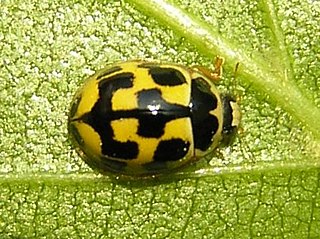
Propylea quatuordecimpunctata is a small lady beetle, belonging to the family Coccinellidae. It is sometimes referred to by the common name 14-spotted ladybird beetle, or simply P-14.
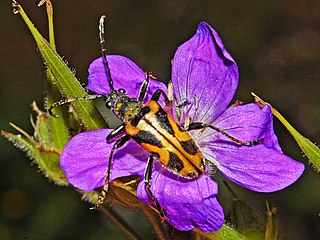
Brachyta interrogationis is the species of the Lepturinae subfamily in long-horned beetle family. This species was described in 1758 by Carl Linnaeus in the 10th edition of Systema Naturae under the name Leptura interrogationis.

Pachyta quadrimaculata is a species of the Lepturinae subfamily in long-horned beetle family.

Stenurella melanura is a flower longhorn beetle species of the family Cerambycidae, subfamily Lepturinae.

Ficus variegata is a well distributed species of tropical fig tree. It occurs in many parts of Asia, islands of the Pacific and as far south east as Australia. There is a large variety of local common names including common red stem fig, green fruited fig and variegated fig. A non strangling fig which may reach 30 metres in height. The tree is evergreen when young but becomes briefly deciduous as it grows older. In Australia the fruit are eaten by cassowaries and double-eyed fig parrots.
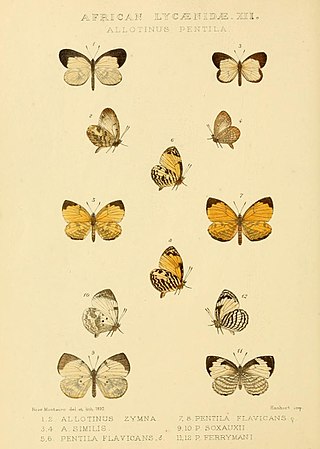
Megalopalpus zymna, the common harvester, is a butterfly in the family Lycaenidae. It is found in Liberia, Côte d'Ivoire, Ghana, Togo, Nigeria, Cameroon, Equatorial Guinea, Gabon, the Republic of the Congo, the Central African Republic, Angola, the Democratic Republic of the Congo, southern Sudan, Uganda, north-western Tanzania and Zambia. The habitat is forest and dense agricultural land.
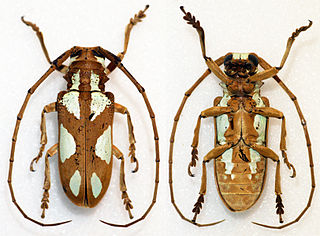
Prosopocera lactator, the Turquoise Longhorn, is a species of flat-faced longhorn beetles in the subfamily Lamiinae.

Tragocephala is a genus of flat-faced longhorn beetles belonging to the family Cerambycidae.

Iris variegata, commonly known as the Hungarian iris, is a plant species in the genus Iris, also in the subgenus Iris. It is a rhizomatous perennial from eastern Europe. It has dark green, ribbed leaves. The branched flowering stems can be as tall as the leaves, they can hold 2–3 flowers in summer. They are yellowish-white, with brown-purple veins on the drooping falls. It is very hardy and it is commonly cultivated as an ornamental plant in temperate regions. There are several cultivars.

Tragocephala castnia is a species of beetle in the family Cerambycidae. It was described by James Thomson in 1857. It has a wide distribution in Africa. It feeds on Theobroma cacao.
Tragocephala ducalis is a species of beetle in the family Cerambycidae. It was described by White in 1856. It is known from South Africa.

Tragocephala formosa is a species of beetle in the family Cerambycidae. It was described by Olivier in 1792, originally under the genus Lamia. It is known from Mozambique, South Africa, Malawi, Kenya, and Zimbabwe, and has been introduced into Seychelles.

Tragocephala guerinii is a species of beetle in the family Cerambycidae. It was described by White in 1856. It has a wide distribution in Africa. It feeds on Calliandra houstoniana var. calothyrsus and Theobroma cacao.

Tragocephala jucunda is a species of beetle in the family Cerambycidae. It was described by Gory in 1835, originally under the genus Lamia. It is known from South Africa and Madagascar.
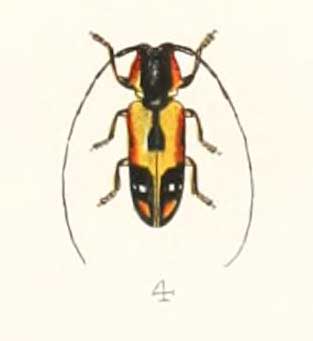
Tragocephala mniszechii is a species of beetle in the family Cerambycidae. It was described by James Thomson in 1857. It has a wide distribution in Africa.

Tragocephala nobilis is a species of beetle in the family Cerambycidae. It was described by Johan Christian Fabricius in 1787, originally under the genus Lamia. It has a wide distribution in Africa. It feeds on Coffea arabica. It is preyed on by the parasitic wasp Aprostocetus lamiicidus, and the parasitic fly Billaea vanemdeni.

Tragocephala pretiosa is a species of beetle in the family Cerambycidae. It was described by Hintz in 1909. It is known from Tanzania, Malawi, Kenya, and Zambia.



















